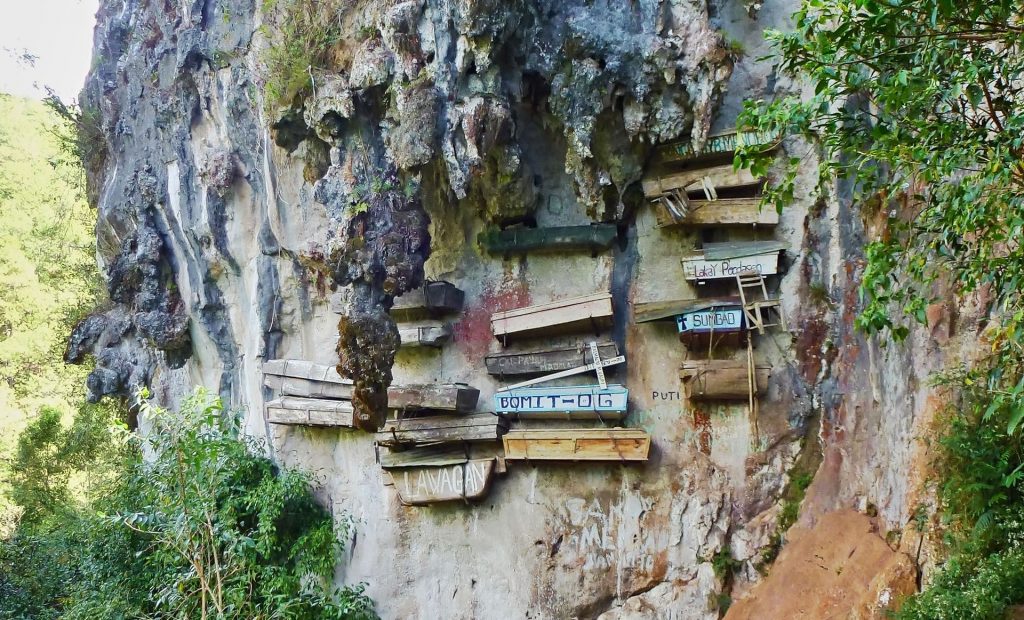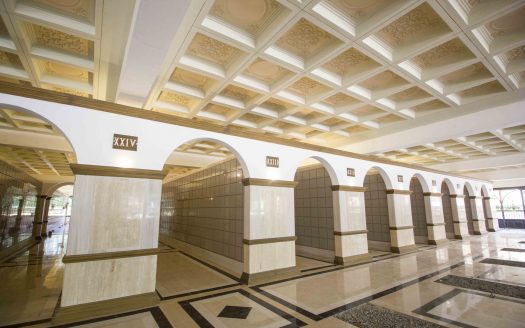Distinct Burial Ceremonies in the Philippines
Distinct Burial Ceremonies in the Philippines written by: Kyla Belle Masangkay
Ceremonies, in general, acknowledge significant moments in our lives from our birth until our passing. It mirrors our values, beliefs, and culture in which we identify ourselves to be. Some ceremonies celebrate our years in life and some for our vows of love. At the same time, there are also ceremonies meant to reflect the sad reality of death. As a tradition, family and friends share feelings and thoughts on the dead’s life journey during those ceremonies. The expression of grief and respect to the deceased align with their community’s distinguished beliefs and values of providing peace for the dead and hope for the living.
There are different kinds of ceremonial expressions in carrying out a burial for a loved one’s passing. Some Filipinos hang coffins beside cliffs, while others choose to bury the dead inside their homes. All of these burial ceremonies are traditionally valid in expressing our identities as Filipinos. Such that the existence of several Filipino burial ceremonies across the country amplifies the richness of our culture. If hanging coffins, backyard burials, and smoking corpses pique your interest, take a read on some of the different burial ceremonies in the Philippines.
Different Burial Ceremonies in the Philippines
- Igorots’ Hanging Coffins
One of the unique ways of burying a body is witnessable in the mountains of Sagada. It has attracted local and foreign tourists to visit the place because of this. Members of the Igorot tribe have long practiced hanging coffins beside cliffs either by tying or nailing them. In believing that the closer the coffin is to the sky, the closer the dead is to heaven. Some also believe it is because their ancestors feared being buried under the ground will cause their bodies to decay quicker. Although in time, coffins fall from the cliffs as they weaken and decay.
Before burying the body, they put the deceased on the sangadil, also known as a death chair, near or in front of their houses for people to pay their respects. After a few days of having their eyes closed and limbs tied together, they arrange the body in a fetal position to fit the coffin. To this day, there are still some who continue to keep the 2,000-year-old tradition alive.
- Smoking Corpses in Abra
Indigenous people from the Northwestern Luzon called Tinguian to have closely similar burial ceremonies with those at Sagada. The loved ones of the departed bathe the deceased first with the belief that bathing them will clean their spirits. Distinctively, the Tinguian people dress the dead in their most beautiful garments and accessories such as beads while they sit with valuable woven cloths. Sometimes, they place a cigarette between the lips of the deceased and lits it from time to time. Thus, leaving the bodies smoking for several days or even weeks before they lay them to rest.
- Tree Trunk Burials of Caviteños
For other Filipinos, they believe trees serve as the final resting places. Some locals in rural areas of Cavite prove that to be true as they bury their departed loved ones in trees. When a person is dying in their community, they have the freedom of choosing the tree they would settle in. And at their deaths, their bodies are vertically put inside the excavated tree trunks to work as their coffins. Similarly, the B’laan of Southern Mindanao also utilizes trees as their burial spots. One of their burial traditions is to cover the dead with tree bark and suspend the body on tree branches.
- Departed Loved Ones Underneath Houses
In the Northern part of Luzon, the Isneg people, also called Apayaos, follow the custom of burying the deceased underneath their houses or backyards. Most people may find it disturbing to have dead bodies under their homes but not Apayaos. They perceive this tradition as a way of showing their love and longing for the deceased. Another reason for doing so is to take ownership of the land. That is why some continue to practice this burial ceremony even though cemeteries are now available in their areas.
- Catholic Burial
Having a majority of Filipinos Catholic, this burial ceremony is the most common in the country. Shaped by the Catholic faith, Christians have their wakes for 3 to 5 days or even a week for families, friends, and acquaintances to pay their respects. The departed one lays inside the casket, typically in their own houses or at available funeral homes. On the day of the burial, the funeral procession starts with a hearse fetching the casket to Church. When the funeral service and mass end, they deliver the coffin to the burial place, usually in a memorial park. There is a traditional timeline of at least 6 weeks for people to mourn. They wear black attires to express their grief and loss.
Preserving Memories of Your Loved Ones
All of these unconventional burial customs may be uniquely different yet hold the same intent of providing a tranquil passing for the deceased the same way our ancestors did. If given a choice, how and where would you want to be buried? Would you desire to be beside a cliff, inside a tree trunk, underneath a house, or at a memorial park? Luckily, memorial parks now are practical and accessible solutions for attaining hassle-free funeral services. Also, a peaceful location to honor our departed loved ones. That is why more Filipinos favor acquiring the services and burial lots in memorial parks such as Golden Haven.
Building Legacies with Golden Haven
With over 30 locations nationwide, Golden Haven stands to have the finest memorial parks in the Philippines. As it is the largest memorial park developer in the country, Golden Haven offers a variety of eco-themed parks presenting quality memorial lot investments. Not only that, it provides complete death care services that seek to walk through its clients in the process of support, healing, and celebration of the departed’s legacy. Because Golden Haven continuously preserves memories and builds legacies at present and in the years to come. Thus having a lot to offer for Filipinos, now is the right time to inquire and invest with Golden Haven.
RELATED: First Eco-memorial Park in the Philippines




















